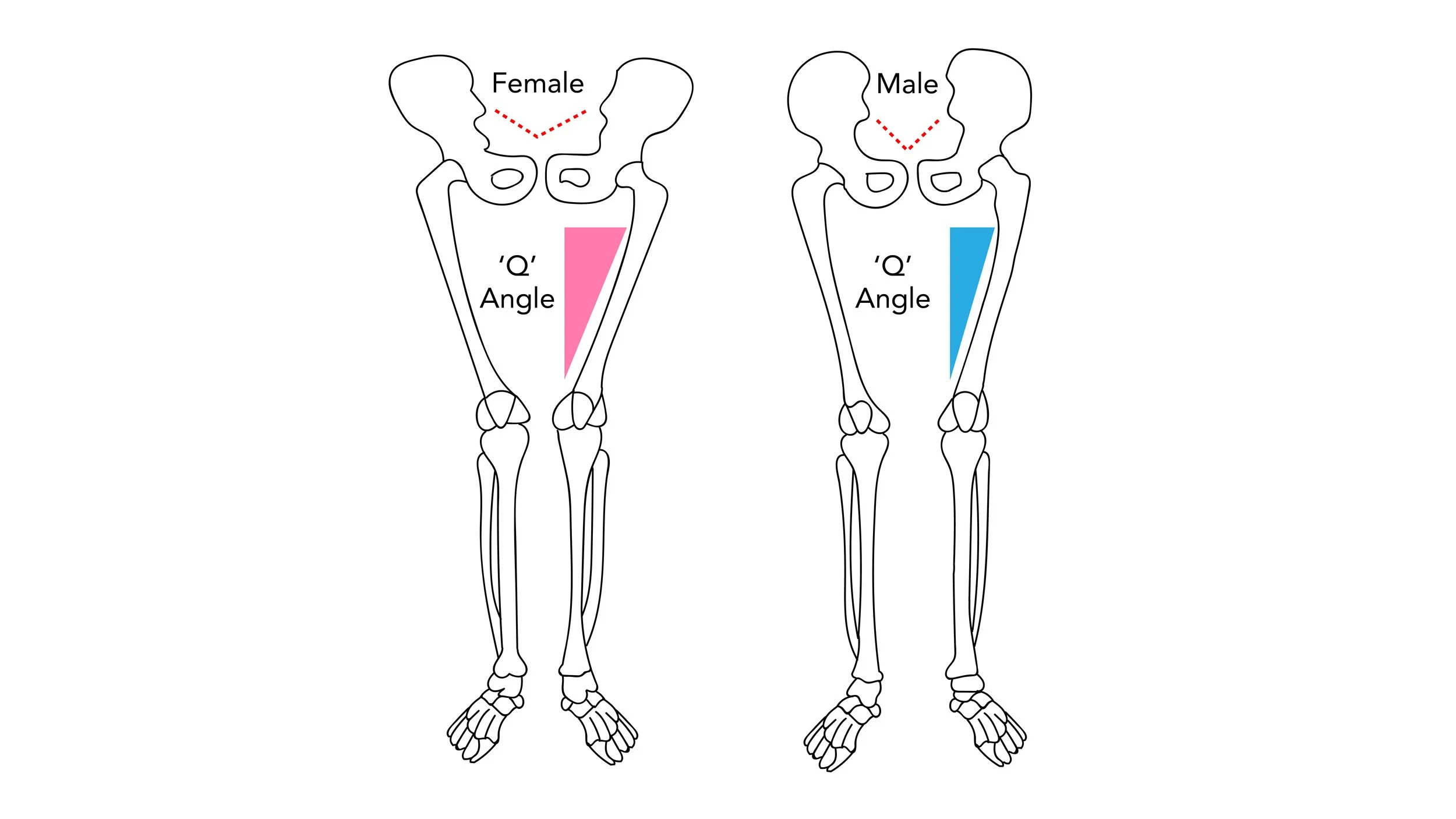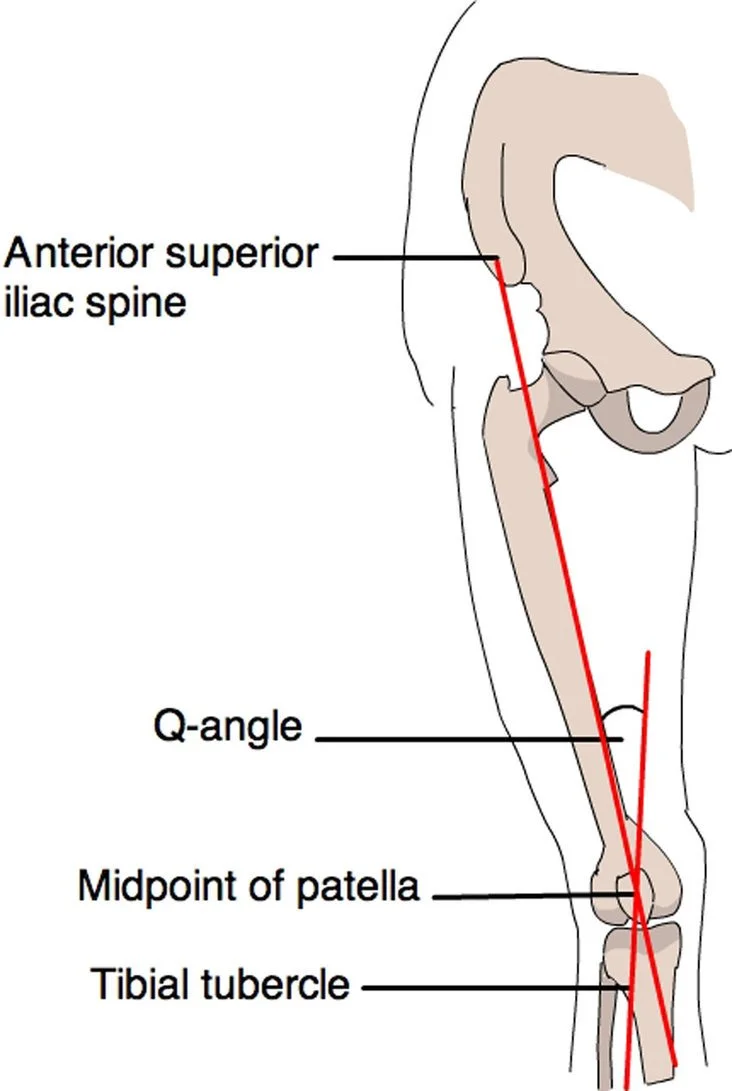Does Q-angle matter?
In athletic performance, many factors are simultaneously at play. The Q-angle is one such factor. But what is the Q-angle, and how does it affect athletes? Let’s delve into the Q-angle and whether it matters in sports.
What is the Q-angle?
The Q-Angle, or quadriceps angle, is the acute angle measured between two lines: one drawn from the anterior superior iliac spine (ASIS) bone to the central patella, and another drawn from the central patella to the tibial tubercle (see below).
Males and females differ in their Q-angles on average. For males, the average Q-angle is 14 degrees (± 3 degrees). Females naturally have wider hips, and therefore have a larger Q-angle of 17 degrees (± 3 degrees).
Effects of Q-angle on the body:
The Q-angle is important in studying biomechanics in the patellofemoral region, as it affects the pressure that the quadricep muscle puts on the kneecap. When something occurs that increases the Q-angle, it increases the lateral force on the patella, which can be harmful. Abnormalities in Q-angle can occur genetically or as a result of injury.
Abnormalities in Q-angle:
There are several conditions associated with an abnormal Q-angle, which occur when the Q-angle falls well outside of the normal range.
Genu valgum (knock knees)
Abnormally large Q-angle
Knees angle in and touch
Feet unable to touch while both legs are straightened
Genu varus (bow legs)
Abnormally small Q-angle
Knees protrude outward
Implications for athletes:
So does Q-angle matter for athletes? Since it impacts the pressure exerted on the patella, it can play a role in knee injuries. Females, who naturally have wider Q-angles, therefore may be more susceptible to knee injuries when engaging in movements like running that engage the knee.
Several studies point to a wider Q-angle increasing the likelihood of sustaining a knee injury or ligament tear in the knee area. But at the same time, there are many other factors other than Q-angle that can contribute to injuries, such as form, rest, and the sport the athlete participates in.
Let’s look at a specific study. A study done on 393 high school cross-country runners involved having each athlete’s Q-angle measured. Throughout the following cross-country season, the runners were assessed on lower body injuries sustained from cross-country practices and races. The study concluded that the athletes with larger Q-angles were more likely to get injured than the athletes with smaller Q-angles, specifically in the knee. Additionally, those with asymmetrical Q-angles between their left and right legs were more likely to injure their shin.
Q-angle and ACL tears:
Let’s delve into another study that attempted to reveal a correlation between Q-angle and knee injury. A study done on 24 U-23 female soccer players in South Africa attempted to investigate whether anatomical features, including Q-angle, were associated with knee injury. The study determined that there is no direct connection between Q-angle knee injuries. An increased Q-angle was not found to cause an increased risk of an ACL tear.
Female athletes have been found to be two to eight times more likely to tear their ACL than male athletes. One might conclude that this is due to their naturally larger Q-angles, but these studies have determined that this is not the case. Until further research results in a conclusive answer, it is uncertain whether Q-angle makes a significant difference in knee injury prevalence in men and women.
Conclusion:
So, does Q-angle matter? Can athletes attribute knee injuries to this puzzling measurement? The answer remains unclear. While women have been found to have wider Q-angles on average than men, it is hard to say whether that difference has a significant impact on injuries. Studies have yielded conflicting results, and the plethora of factors that influence injury make it difficult to fully determine the role of the Q-angle in athletics. Athletes looking to prevent knee injury can look to other factors that are within their control. Proper rest, stretching, and form will reduce the risk of injury and keep you from spending the competition on the bench.
Sources:
Griffin, Shareikka L., "Does an Increased Q-angle Increase the Risk of Anterior Cruciate Ligament Tears in Female Athletes?" (2020). Physician's Assistant Program Capstones. 59. https://scholarlycommons.pacific.edu/pa-capstones/59
“Knee - Q angle of the Knee.” Wheeless' Textbook of Orthopaedics, https://www.wheelessonline.com/joints/q-angle-of-the-knee/.
“Q Angle.” Physiopedia, https://www.physio-pedia.com/Q_Angle.
Macmillan, Carrie. “Are ACL Tears Really More Common in Women?” Yale Medicine, 14 February 2020, https://www.yalemedicine.org/news/sports-injuries-gender.
Mohamed EE, Useh U, Mtshali BF. Q-angle, Pelvic width, and Intercondylar notch width as predictors of knee injuries in women soccer players in South Africa. Afr Health Sci. 2012 Jun;12(2):174-80. doi: 10.4314/ahs.v12i2.15. PMID: 23056024; PMCID: PMC3462540.
Rauh, Mitchell J., et al. “Quadriceps Angle and Risk of Injury Among High School Cross-Country Runners.” Journal of Orthopaedic & Sports Physical Therapy, vol. 37, no. 12, 2007, https://www.jospt.org/doi/pdf/10.2519/jospt.2007.2453.



